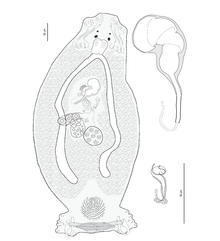Pseudorhabdosynochus manifestus
Pseudorhabdosynochus manifestus is a diplectanid monogenean parasite first found in host Epinephelus malabaricus near Nouméa, between its secondary gill lamellae. It can infest its host by the hundreds. It was ascribed that name because it was the most abundant species found while its descriptive study was taking place.[1] As appreciated from studying juvenile specimens, the development of female organs precedes that of male organs in this species and is likely the case in other Pseudorhabdosynochus species.[1]
| Pseudorhabdosynochus manifestus | |
|---|---|
 | |
| Pseudorhabdosynochus manifestus | |
| Scientific classification | |
| Kingdom: | |
| Phylum: | |
| Class: | |
| Subclass: | |
| Family: | |
| Genus: | |
| Species: | P. manifestus |
| Binomial name | |
| Pseudorhabdosynochus manifestus Justine & Sigura, 2007 | |
Pseudorhabdosynochus huitoe, Pseudorhabdosynochus shenzhenensis and Pseudorhabdosynochus serrani all share with P. manifestus: a sclerotised vagina with a conical primary canal with one lonely coil anteriorly, and small primary and secondary chambers. P. huitoe, furthermore, shares P. manifestus' characteristic spherical primary chamber with a think internal wall. P. manifestus is different by having a longer vagina, and morphological differences in the quadriloculate organ and hamuli.[1]
P. shenzhenensis and P. serrani also differ from P. manifestus by measurements of hamuli and quadriloculate organs, which are greater in the latter. At the same time, the former do not show a distinctive ring in the posterior part of the primary canal, while the shape of their chambers is different as well. Finally, tegumental scales could also show morphological differences amongst these species.[1]
Description
It has an elongate body, with a length of about 670 µm and a width of about 290 µm. It possesses a scaly tegument, 3 pairs of head organs and 2 pairs of eyespots. The haptor is differentiated from its body, being less wide (about 220 µm), and exhibits 2 round squamodiscs, 2 pairs of lateral hamuli, 3 bars and 14 hooklets. There is a groove visible on the ventral side of its flat ventral bar.[1]
It has a subspherical pharynx, with a length of about 50 µm, and lacks an esophagus, its intestinal bifurcation following the latter organ. It shows a simple caeca that terminates at the level of the posterior margin of its vitellarium. Its testis are also subspherical and intercaecal, with a length of approximately 70 µm; its quadriloculate organ with an inner length of about 51 µm. At the same time, its ovary is subequatorial, intercaecal and pretesticular, encircling the right caecum, with a width of about 80 µm. Its oviduct forms the ootype and is surrounded by the Mehlis gland; the ootype opens into the uterus. It counts with an unsclerotised, dorsally question mark-shaped vagina that is elongate; its total length is about 35 µm.[1]
References
- Justine, Jean-Lou; Sigura, Aude (2007). "Monogeneans of the malabar grouper Epinephelus malabaricus (Perciformes, Serranidae) off New Caledonia, with a description of six new species of Pseudorhabdosynochus (Monogenea: Diplectanidae)" (PDF). Zootaxa. 1543: 1–44.

Further reading
- Schoelinck, Charlotte; Justine, Jean-Lou (2011). "Four species of Pseudorhabdosynochus (Monogenea: Diplectanidae) from the camouflage grouper Epinephelus polyphekadion (Perciformes: Serranidae) off New Caledonia". Systematic Parasitology. 79 (1): 41–61. doi:10.1007/s11230-010-9289-0. ISSN 0165-5752. PMID 21487947.
- Justine, Jean-Lou; Vignon, Matthias (2008). "Monogeneans of the grouper Epinephelus tauvina (Perciformes, Serranidae) off Moorea, French Polynesia, with a description of Pseudorhabdosynochus pai n. sp. (Monogenea: Diplectanidae)". Systematic Parasitology. 72 (2): 113–125. doi:10.1007/s11230-008-9159-1. ISSN 0165-5752. PMID 19115085.
- Justine, J.-L. 2010: Parasites of coral reef fish: how much do we know? With a bibliography of fish parasites in New Caledonia. Belgian Journal of Zoology, 140 (Suppl.), 155-190. Free PDF
